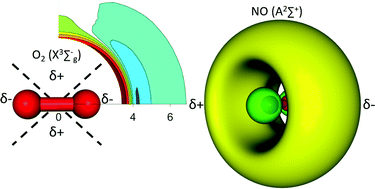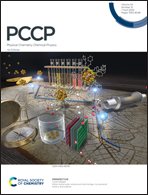Molecular properties and excited state van der Waals potentials in the NO A2Σ+ + O2 XΣg− collision complex†
Abstract
We characterize NO A2Σ+ + O2 X3Σg− van der Waals (vdW) Potential Energy Surface (PES) with RHF/RCCSD(T) and CASSCF/CASPT2 calculations. To do this, we first assess our computational setup to properly represent the individual molecular properties of O2 X3Σg−, NO X2Π, and NO A2Σ+. Specifically, we show that highly augmented basis sets are necessary to properly represent the NO A2Σ+ polarizability. Then, we optimize different vdW geometries, and provide BSSE corrected plots of the quartet vdW PES. The surfaces show a confined channel at a distance of approximately 6 Å with a depth of at least 20 cm−1 that we believe is caused by NO A2Σ+ hyper-polarizability. At shorter distances, the channel is connected to a vdW basin centered around the O–N O–O linear geometry with an inter-molecular separation of 4.3 Å, and a depth of 95 cm−1 at the RCCSD(T) level. A CASPT2 scan along the linear geometry show that this vdW basin exists on both the doublet and quartet excited surfaces. These results infer the existence of a collision complex between NO A2Σ+ and O2 X3Σg−, as predicted by earlier experiments.



 Please wait while we load your content...
Please wait while we load your content...